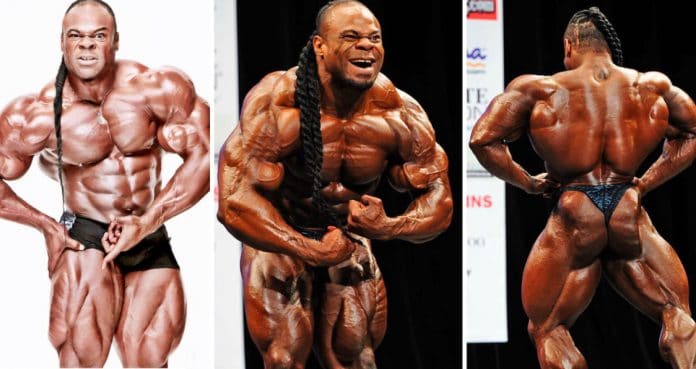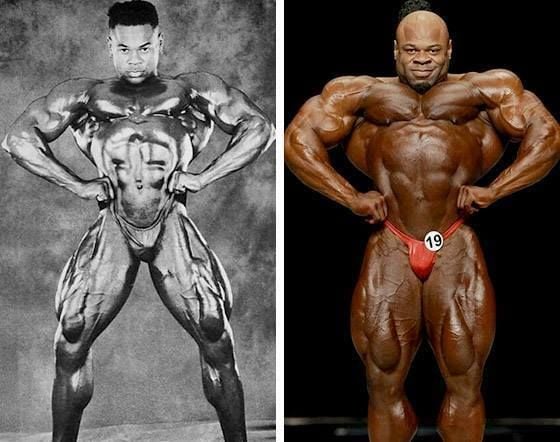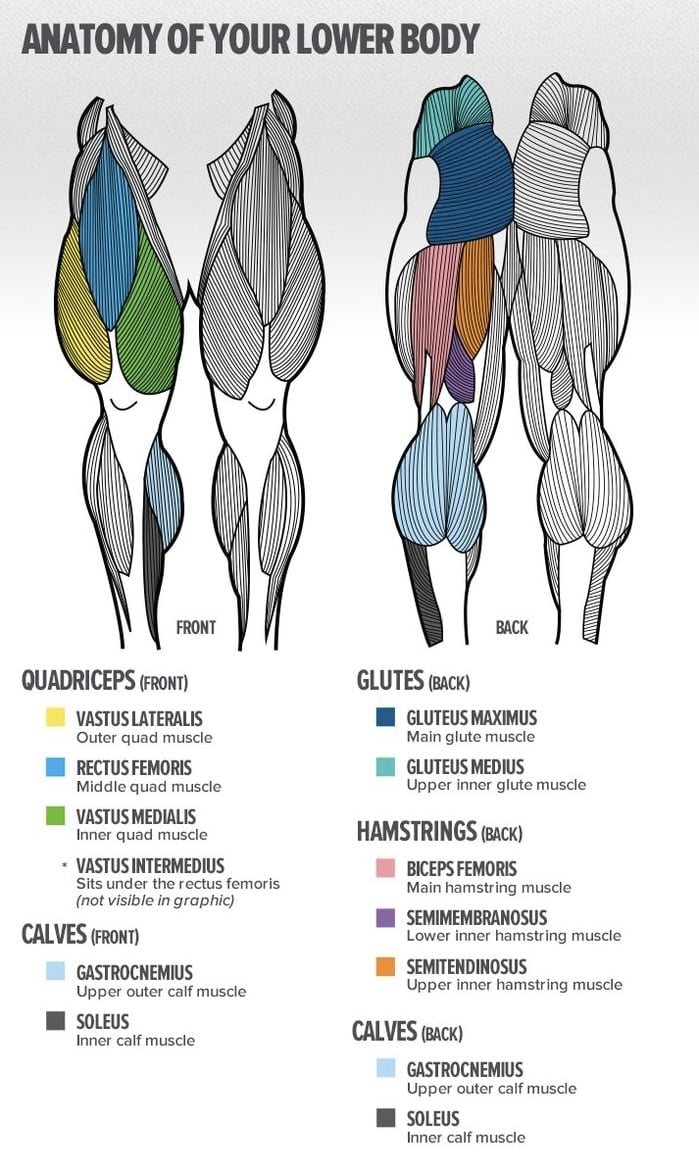
Kai Greene Leg Workout Routine
Kai Greene is one of the most widely recognized bodybuilders of our time. His mind-blowing physique, inspirational words, incredible artwork, trademark hairdo (and infamous grapefruit video) have earned him fans all over the world.
Kai Greene Stats
|
Full Name: Kai Greene |
||
| Weight | Height | Year Of Birth |
| 317 lbs. | 5’8’’ | 1975 |
| Arms | Chest | Thights |
| 22″ | 58″ | 33″ |
Kai Greene made his Mr. Olympia debut in 2009 and competed in the world’s most prestigious bodybuilding contest until 2014. Kai Greene’s Mr. Olympia track record:
- 2009 – 4th place
- 2010 – 7th place
- 2011 – 3rd place
- 2012 – 2nd place
- 2013 – 2nd place
- 2014 – 2nd place
Related: Is Kai Greene Challenging Phil Heath In Recent Tweet?
For four years in a row (2011-14), Kai Greene came close (but not close enough) to conquering the throne. Some fans consider Greene a part of the “uncrowned Mr. Olympia” club accompanying bodybuilding legends like Flex Wheeler, Kevin Levrone, and Shaun Ray.
The Predator’s legs are one of the biggest reasons behind his success on stage. Greene’s vastus medialus (quad teardrop) striations are unmatched, hams in perfect symmetry with quads, and his calves have a life of their own.
But before we dive into Kai Greene’s leg workout, let’s get to know him a little better. Shall we?
Also Read: TOP 6 UNCROWNED BODYBUILDERS OF ALL TIME
The Kai Greene Story

Born and raised in Brooklyn, New York, Greene had a tough childhood. After being orphaned at 6-years-old, he spent most of his youth in foster homes.
Throughout his younger years, Kai struggled to find a place in the community. The ensuing feeling of being an outcast turned Greene into a trouble child. His regular misconducts put him at risk of being kicked out from both his school and foster home.
Finding The Anchor

Weight training came as Kai Greene’s saving grace. Greene started training at the age of 13 and used the gym as an escape from all his problems.
Kai’s 7th grade English teacher realized his bodybuilding potential and started encouraging him to compete in teen bodybuilding shows. This little push was all Kai needed to turn his life around.
It did not take Kai Greene too long to realize that he had great bodybuilding genetics. He was growing faster than others his age and was beating kids older than him at bodybuilding competitions.
Check Out: Decoding Genetics: Check If You Have Bodybuilding Genetics
The Predator Was Born
Over the next five years, Kai Greene competed in various unofficial teen bodybuilding shows. Since Greene was bigger and more jacked than other teenagers his age, he dominated every contest he entered.
By the time Mr. Getting It Done turned 19, he had earned his Pro card in a natural bodybuilding federation, the 1994 NGA American Nationals. The early and quick success made Kai realize that he could make it big in bodybuilding, and make it big, he did.
Kai Greene & His Haitus
Since 2014, Kai Greene fans have been complaining about his absence from the Olympia stage. But hardly do they know, this is not the first time Kai has taken a break from competing.
Kai’s first show as an IFBB Pro was the 1999 World Championships in Slovakia. Although Greene placed 4th, he was not satisfied with his performance.
Determined to work on his weaknesses and sculpt one of the greatest physiques of all time, Kai Greene went back to the drawing board and took four years away from the competitive circuit.
Related: Kai Greene Meets With Universal Execs During Olympia Week
Kai Greene Leg Workout
Because of his size and appearance, many people expect Kai Greene’s workouts to consist of lifting heavy, grunting, and cursing throughout the workout. But, the reality is different.
Kai Greene Workout Principles
It does not matter if Kai is training legs, arms, or back. He swears by the following training principles:
1. Form Is King
Let’s do an activity. It will be worth it, we promise.
Set a five-minute timer, log onto YouTube, and watch (at 2X speed) as many Kai Greene training videos as you can.
Now here is what you need to do – note down every time Kai compromises on his form in favor of lifting heavy. At the end of the five minutes, you will probably have – zero entries.
“The weight is a tool. Do you focus on the hammer or the nail? You better focus on the thing you’re trying to hit.”
2. Mind-Muscle Connection
If you see Kai Greene pose, you would know that he can move each fiber in his body at will. The control he has over his muscles is incredible. Kai’s movements are precise, contractions are hard, and each rep is harmonious with the next.
Bodybuilding is not about lifting as heavy as you can. To sculpt your dream body, you need to contract your muscles and visualize your goal physique with every rep to ensure maximum muscle fiber recruitment.
This technique was first made famous by Arnold Schwarzenegger. If you do not feel a muscle pump by the end of an exercise, you would be better off dropping the weight (and your ego) and trying again.
Next Read: The Importance of Mind-Muscle Connection To See Huge Gains
3. Warm-Up
Kai Greene spends 15-20 minutes warming up before every workout. Benefits of warming up include:
- Improves flexibility.
- Enhances performance.
- Less muscle tension and pain.
- Improved range of motion.
- Increased blood flow and oxygen.
- Lower risk of injury.
Mr. Getting It Done believes that his relatively long warm-up routine gets him in the right mindset to train and improves his focus. According to him, he gets more alert, aware, and his neurological connections get sharper.
Related: Follow This Insane Pro Warm-Up Routine For Ultimate Gains
4. Volume is Key
The Predator uses a lot of sets and reps in his workouts. He does not leave the gym unless he has annihilated his muscles. You will be doing up to four sets of eight different exercises and completing 12-20 reps in each, so get ready for the Kai Greene leg workout.
5. Take Your Time
Take your focus off the clock and put it where it should be – on your lower body. You are not in a race against time here. Take as long as you need between sets. Do not begin the next set until you are properly rested.
Kai Greene Leg Training Routine

Kai Greene’s monster truck wheels are a result of years of hard work and consistency. His leg workouts include a combination of advanced training principles and a variety of exercises to train his lower body from different angles.
The Predator’s legs are one of his strengths, but it was not always this way. He has been training for over 20 years with a focus on sculpting the perfect pair of wheels. Greene is presently working on adding more detail to his upper legs and making them rounder.
1. Superset
- Glute Kick-Back: 4 sets 20 reps
- Hip Abductor: 4 sets 20 reps
Kai Greene trains in a specific order that addresses body parts from weakest to strongest. He believes that it helps him build better muscular symmetry.
Greene starts his leg workouts with glutes and then transitions to training his calves, then hams because, according to him, that is the order of needed improvement. He trains his quads in the end because they are superior to other parts of his legs.
2. Superset
- Standing Calf Raise: 4 sets 20 reps
- Seated Calf Raise: 4 sets 20 reps
There are no accessory muscles on Mr. Getting It Done’s training program. Kai performs four sets each of standing and seated calf raises. While the standing variation trains the gastrocnemius, seated calf raises are optimal for training the soleus muscle.
Kai Greene uses the standing calf raise machine for the first leg of the superset. If you do not have access to a standing calf raise machine at your gym, you could use a smith machine with an aerobic stepper or a leg press machine for the exercise.
While performing calf exercises, you need to make sure you are following a full range of motion. Your heels should only be a couple of inches away from the floor at the bottom of the movement. On the other hand, at the top of the movement, you should look like a ballerina on her toes.
Related: 10 Reasons Why You’ll Never Have Big Calves
3. Superset
- Jefferson Squat: 4 sets 20 reps
- Hip Adductor: 4 sets 20 reps
Kai Greene played a big role in bringing back the Jefferson squat.
Named after circus strongman Charles Jefferson (1863-1911), the unique squat variation can help increase leg strength, size, core stability, and build power in multiple planes of movement.
How To Perform Jefferson Squat:
- Stand over a barbell, facing one of the weighted ends with the bar between your legs. Your front foot should be facing forwards, and your rear foot rotated 90 degrees outwards.
- Place your feet at a distance so that as you go down into your squat, your knees are directly above your ankles.
- Squat down over the bar and grab it using a mixed grip with one hand behind you and one in front of you.
- Drive down into the ground through your feet and stand tall, bringing the barbell straight up between your legs.
- Return to the starting position with a slow and controlled motion.
- Repeat for recommended reps.
4. Unilateral Standing Leg Curl: 4 sets 20 reps
Unilateral standing leg curl is an incredibly effective exercise to target your hams individually. It is especially beneficial for people whose hams are lagging their quads, glutes, and calves.
Standing leg curls can also limit the use of momentum and jerking motions. Keep your toes pointed throughout the exercise to ensure maximal hamstring muscle fiber recruitment.
5. Lying Leg Curl: 4 sets 20 reps
Kai Greene likes to think about his hams as piano wires throughout the entire range of motion. You do not want to be moving the weight primarily focusing on your shins or lower body. At the top of the movement, focus on squeezing your hams.
Lying leg curl can do for your hams what bicep curls do for your biceps. Perform the exercise with a slow and controlled movement, and you will feel every fiber of your hamstring working.
The Predator does not limit his workouts to a pre-defined number of sets. If he feels that he was not focused during the first couple of sets, he makes up for it by performing couple more sets of the exercise.
Remember – bodybuilding is not about going through the motions. Your goal should be muscle annihilation.
6. Barbell Stiff-Legged Deadlift: 4 sets failure
For the barbell stiff-legged deadlift, Kai Greene uses relatively lightweight. To put maximum tension on his hamstrings, he turns his toes in and points his heels outwards (forming an “A” with his feet) while performing the lift.
The Predator maintains a slight bend in his back throughout the exercise and uses his hamstrings and glutes to move the weight.
If you cannot perform the movement with a 2:1:2:1 rep tempo (two seconds on the way down, a second’s pause at the bottom, two seconds on the way up, and a second’s pause at the top), and have to jerk your body up and down to punch out the reps, you are probably going too heavy.
7. Squat: 5 sets 20 reps
No, this is not a typo. Kai Greene gets to the squat rack at the end of his leg workout. Since you will be fatigued at this point in your workout, you need to make sure you are not compromising on your form.
Mr. Getting It Done maintains total control for the entire set and length of each rep. Rather than dropping down and blasting up, Kai focuses on feeling every inch of the rep and tries to intensify the contraction on his legs.
8. Leg Press: 5 sets 20 reps
Unlike most lifters, Kai Greene does not like to go super heavy on the leg press machine. While fitness noobs focus on locking out their knees and squeezing their quads at the top of the movement, Greene tries to contract his legs throughout the entire rep.
If you can only move the weight a few inches while performing the leg press, it is a sign you have more weight on the machine than you can handle.
Wrapping Up
The next time you hear fitness gurus talking about why Kai Greene cannot make a comeback, remind yourself that the guy in question here has no qualms taking four years off if he believes he can bring a better package to the stage. Should you be doubting his commitment and ability? They don’t call him Mr. Getting It Done for nothing.
Who, according to you, has the best legs in the fitness industry? Let us know in the comments below. Also, be sure to follow Generation Iron on Facebook, Twitter, and Instagram.
